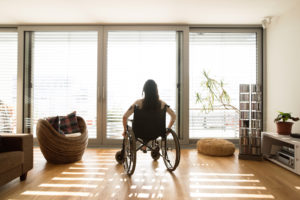 For many people with disabilities and seniors, personal care services can assist them with completing daily tasks that may allow them to remain in their communities rather than move to a nursing home or other institutional facility.
For many people with disabilities and seniors, personal care services can assist them with completing daily tasks that may allow them to remain in their communities rather than move to a nursing home or other institutional facility.
However, hundreds of thousands nationwide are on waiting lists to enroll in such home- and community-based services. A newly reintroduced bill — the Better Care Better Jobs Act — seeks to address this issue.
Challenges Facing Home- and Community-Based Services (HCBS)
As of 2021, more than 655,000 people across the country were on waiting lists to receive home and community-based services (HCBS) covered under Medicaid. This population remains unserved.
Due to the lack of access to such services, many older and disabled people rely on family members to provide the care they need. While family members may often be willing to care for their aging or disabled loved ones, this sacrifice usually comes at a significant financial loss.
Taking on the role of a full-time caregiver can mean providing care that is typically round-the-clock, or nearly so. Fulfilling the needs of their ailing loved ones may leave very little time for family caregivers to work a full-time job. As a result, they often must reduce their hours and pay, or leave their jobs altogether.
Meanwhile, much of the home care professional workforce lives under the poverty line, earning a median wage of $13 per hour to provide this type of care. This contributes to high turnover rates across the profession, adding to what has already been a challenging shortage in direct care workers amid the pandemic.
With HCBS funded through Medicaid, each state organizes its programs differently. Requirements to become eligible for HCBS, the number of people who can enroll in these services, and availability can all vary from state to state.
HCBS Services and the Better Care Better Jobs Act
Originally proposed in June 2021 and reintroduced in January 2023, the Better Care Better Jobs Act focuses on improving the lives of seniors, people with disabilities, and others in need of HCBS, as well as those who may have sacrificed upward economic mobility to serve as their caretakers.
Led by Senator Bob Casey (D-PA) and Congresswoman Debbie Dingell (D-MI-6), the Better Care Better Jobs Act seeks to make a “generational investment in home care.” In striving to make HCBS available to more people in need while offering increased support to the workforce that provides these crucial services, the act seeks to:
- Give states a permanent 10 percent increase in Medicaid match funding for home and community-based services.
- Provide permanent spousal impoverishment protections.
- Make the Money Follows the Person program permanent.
- Expand the eligibility limits to allow millions of new Medicaid recipients to receive home and community-based services.
- Create hundreds of thousands of new jobs – with increased wages – for direct care workers.
Benefits for Seniors, People With Disabilities, and Their Caregivers
With increased funding, the Better Care Better Jobs Act is intended to help alleviate the financial burdens of providing in-home personal care for generations of low-income families.
The cost of long-term nursing homes or inpatient rehabilitative care can quickly drain a patient’s life savings and leave a family in massive debt for years to come. Without that burden, families can better plan for the patient’s future and preserve the family’s financial well-being.
Seniors and disabled people who wish to remain home, live independently, and continue contributing to their communities may have better opportunities to do so with the support of HCBS.
In turn, the Better Care Better Jobs Act seeks to encourage millions of family caregivers to re-enter the workforce in a field where they are reaching their maximum earning capacity.
“The United States is in the midst of a caregiving crisis,” Sen. Casey said in a news release about the legislation. “Across this nation, seniors and people with disabilities are struggling to find and afford care, forcing families to make difficult decisions like leaving the workforce in order to care for a loved one.”

Recent Comments